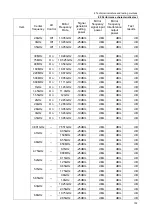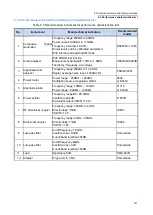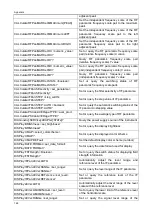
Appendix
142
Appendix
Appendix A Glossary Description
………………………………………………………………………147
Appendix B SCPI Command Quick Reference Table
………………………………………………152
Appendix C Quick Reference Table of Error Messages
………………………………………………162
Annex A Terminology
Units of measurement
The units of measurement commonly used for monitoring receivers are shown in Table 1.
Table 1 Measurement Units
Measurement parameters
Name of Unit
Unit Abbreviation
Freq
Hertz
Hz
Power level
Decibel relative to milliwatt
dBm
Power ratio
Decibel
dB
Voltage
Volt
V
Time
Second
s
Impedance (resistance)
Ohm
Measuring range
The power ratio (dB) of the maximum signal (typically the maximum safe input level) to the minimum
signal (display average noise level) that can be measured at the input of the monitoring receiver for a
given accuracy range, which is typically much greater than the dynamic range possible in a single
measurement.
Logarithmic scale display
The vertical scale on the display is displayed logarithmically. In the logarithmic mode, dBm
and dBμV
can be used as magnitude units.
Trace
A trace consists of a series of data points containing frequency (time) and amplitude information, which
are usually treated as a set.
Frequency scale
The visible indicator cursor, which can be placed anywhere on the screen trace, provides a digital
display of the absolute value of the frequency and magnitude of the trace at the marker point. Active
frequency scales are those located on the trace that can be moved directly by dragging or programmed
commands.
Differential frequency scale
One way of marking frequency scale, one of which is a fixed reference marker, and the other is an active
frequency scale that can be placed anywhere on the display trace, and the displayed data is the relative
amplitude and frequency difference (or time difference) between the active marker and fixed reference
frequency scale.
Filter selectivity
Filter selectivity, also known as the rectangular coefficient, is an indicator for evaluating the ability of a
monitoring receiver to resolve unequal amplitude signals, and usually defines the ratio of the 60dB
bandwidth to the 3dB bandwidth of the filter. The bandwidth selectivity indicates the steepness of the
filter edge.
LO
The short for the local oscillator. In the monitoring receiver, the local oscillator frequency is mixed with
the received signal to generate the intermediate frequency signal of instrument.






























